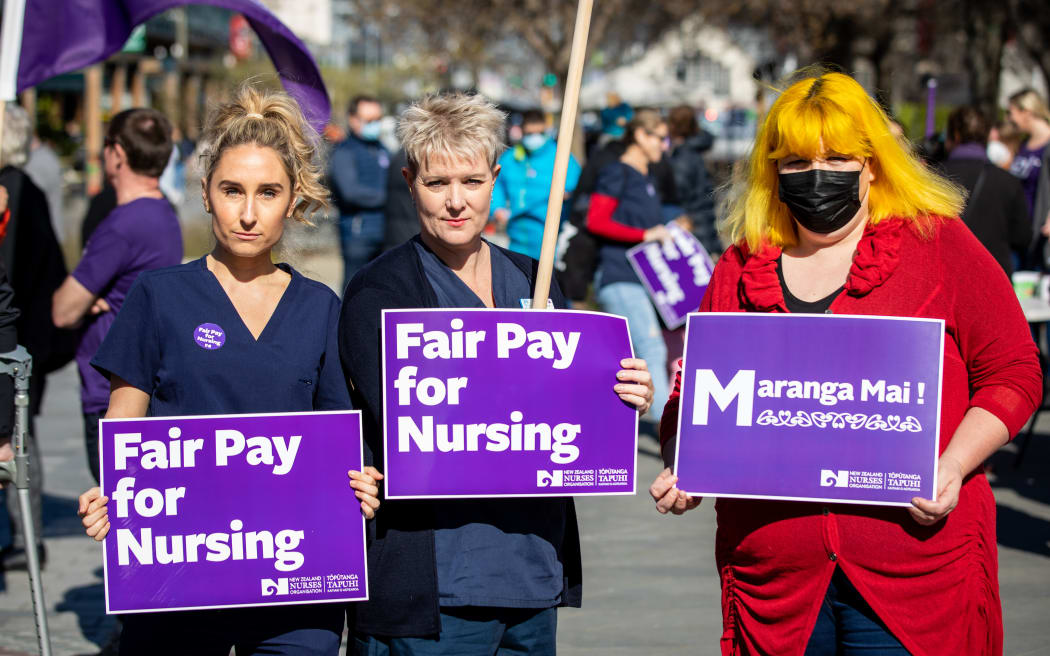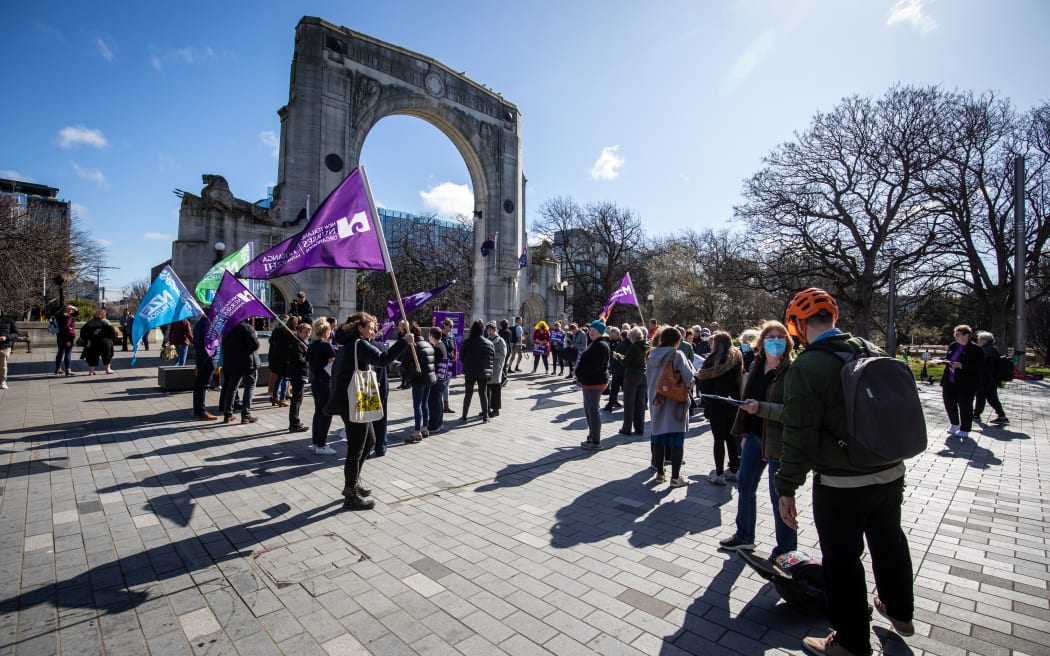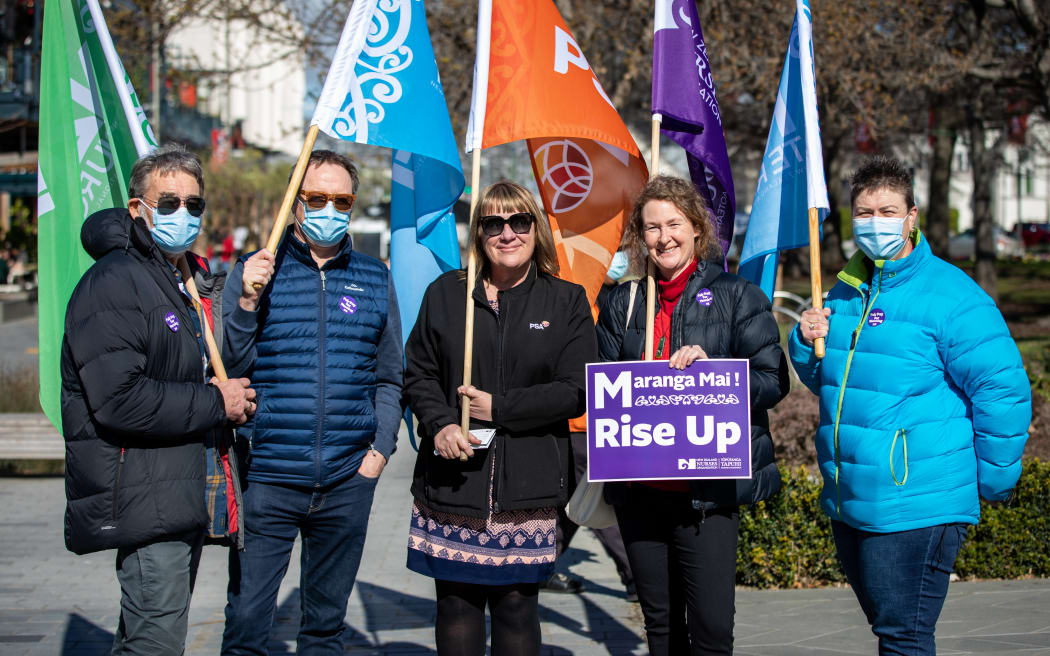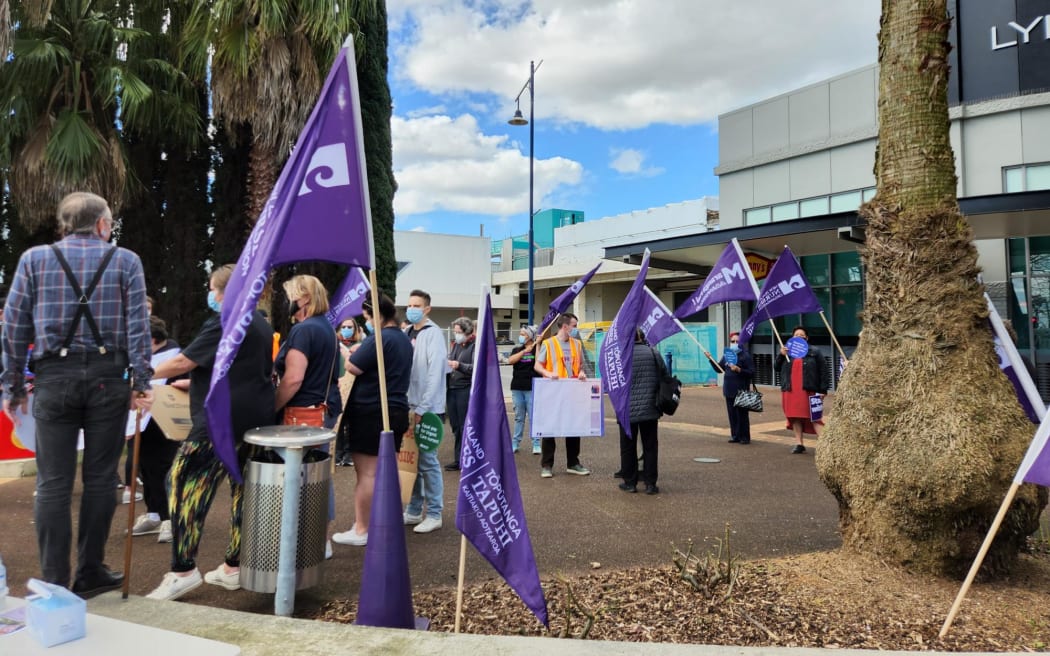Nurses took to the streets across the country today over what they say is pay disparity between community nurses and their counterparts in hospitals.
Their union says nurses who work in primary care, such as GP clinics and for Plunket, are being paid much less than Te Whatu Ora nurses.
New Zealand Nurses Organisation president Anne Daniels said although primary health care nurses had the same qualifications as nurses who fell under the new Te Whatu Ora Health New Zealand, they were paid less – sometimes up to 25 percent less.
Daniels was at the rally in Wellington and said the union was fighting against injustice for primary care nurses who were underpaid and under valued.
“They were the frontline during the Covid outbreaks, doing the vaccinations and the testing. They are the ones that help us stay well in the community, and reduce the pressures in the hospitals. But for all of that, they are paid less than nurses who work in the hospital.”
 Nurses and supporters hold signs at the rally in Christchurch on 29 August. Photo: RNZ / Nate McKinnon
Nurses and supporters hold signs at the rally in Christchurch on 29 August. Photo: RNZ / Nate McKinnon
One primary health care nurse in Auckland wanted to see acknowledgement for the huge portfolio they carried.
“I think it’s unfair that primary healthcare nurses aren’t paid at the same rate as DHB nurses. We put our hearts and souls into our jobs and we deserve the fair reparation for it.”
It was a message echoed by primary care nurse Lizzy in Wellington.
“We don’t come into nursing for the money we come into it because we love it. But actually we also need an equitable salary to survive and pay rates and raise a family.
 Community nurses rally were making their voices heard at the rally in Christchurch today. Photo: RNZ / Nate McKinnon
Community nurses rally were making their voices heard at the rally in Christchurch today. Photo: RNZ / Nate McKinnon
Another person at one of the rallies had a clear message to the government: “You’ve already signalled that you understand that pay parity needs to happen, so make it happen and make it happen right now.”
A mother who attended the rally to support her daughter, who was a nurse and iwi provider, was equally critical of the pay conditions.
“She gets pitiful pay. They’re not even on the MECA [multi-employer collective agreement]. They can’t hold nurses and they can’t hold doctors and Māori providers need to get their act together and pay them equal.”
 The nurses union says some community nurses are paid 25 percent less than their Te Whatu Ora counterparts. Photo: RNZ / Nate McKinnon
The nurses union says some community nurses are paid 25 percent less than their Te Whatu Ora counterparts. Photo: RNZ / Nate McKinnonTairāwhiti rural nurse Gina Chaffey-Aupouri (Ngāti Porou) said nurses had been overworked and undervalued for some time.
“It’s really important that the minister realises that HealthCare New Zealand has 80 percent of funding and the Māori Health Authority have 20 percent,” she said.
“We just want some equity.”
 A small group gathered in Auckland today to highlight the inequity between nurses. Photo: RNZ / Finn Blackwell
A small group gathered in Auckland today to highlight the inequity between nurses. Photo: RNZ / Finn BlackwellGreen MP Jan Logie said she understood the barrier for closing the pay gap was government funding and called on Minister of Health Andrew Little to act.
“It’s a pretty obvious call for action for the minister to come to the table the ensure that that money is there for them to be able to actually get the pay they deserve.”
NZNO said employers want to pay their staff the same rates as Te Whatu Ora nurses, but they could not without increased funding from the government.
A Te Whatu Ora – Health New Zealand spokesperson said negotiations were underway to establish a new Primary Health Care multi-employer collective agreement (MECA).
“The Primary Health Care MECA is currently being worked through between the NZ Nurses Organisation, and employers such as Green Cross Health and a number of PHOs.
“Te Whatu Ora – Health New Zealand is not party to the Primary Health Care MECA which covers about 60 percent of the general practice nursing workforce. Te Whatu Ora has played a role by providing analysis to both employer and employee representatives to support these negotiations. This analysis was independently peer reviewed – and it outlined that the PHO Services Agreement has an agreed process to quantify cost pressure increases in general practice. This includes salary and wage increases for primacy health care nurses.
“Through this process, an estimated $86.34 million in new base funding has been provided to general practices over the last two financial years – $52.67m of which is available for workforce pressures. This is more than the anticipated $7.7m cost of implementing the new Primary Care Nursing MECA ($12m for total nursing workforce).”
To acknowledge the higher inflation rate in the first part of 2022, Te Whatu Ora had offered a 3 percent increase to frontline general practice services, the spokesperson said.
